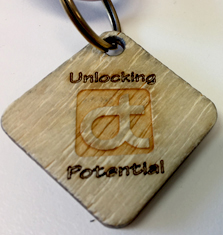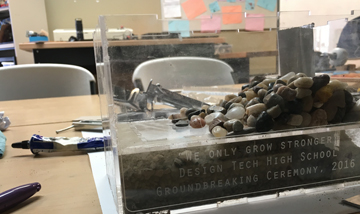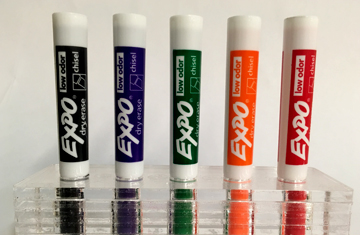Makerspace at Design Tech (d.tech) High School Accelerates Ideas
by Ken Montgomery | August 08, 2017
A recent Infy maker Youth Award winner, Markus nominated his school Design Tech High School @dTechHS to receive a grant for a Makerspace. Executive director of d.tech Ken Montgomery shares how this new makerspace is helping d.tech students build their creative confidence.
"When you create something the thing that you change the most is yourself."
Design Tech High School (d.tech) is a charter school serving students in grades 9-12 based in Burlingame, CA. Our mission is to develop students who believe that the world can be a better place and that they can be the ones to make it happen. To realize our school’s mission we have developed an educational program that is based on the principles of design thinking. We believe that if students learn design thinking skills and adopt a design thinking mindset that they will develop the optimism and self-efficacy needed to make the mission come alive. As we have taught students design thinking, we have learned that students are great at generating ideas and prototypes, but struggle when they are asked to turn their ideas into action.
Over the course of three years, our biggest challenge has been supporting the implementation of student ideas generated in design lab. The Makerspace grant from Infosys Foundation USA was used to support the creation of our accelerator program, which we run out of our Design Realization Garage, or DRG. The funds were used to purchase materials and supplies needed to prototype the idea of an accelerator program. We have held four accelerator courses, which have helped students implement ideas from their design lab class. The accelerator program allowed students to see their ideas come to life, which helped students build creative confidence. Two students, Lian and Lucy, illustrate the impact of this grant quite well.

Lian is a 9th grader at d.tech who was high achieving academically, but never considered herself a maker or particularly adept at using technology. Sensing that she might need a nudge, I asked her if she would like to take on a project for the school. She agreed, as would most 9th graders when asked for help by the school principal. I asked Lian to design a key chain for staff with the words "unlocking potential" on it, as I wanted staff to have a constant reminder that our goal as educators is to help students unlock the potential that they have inside them. I asked for her to bring me three prototypes to choose from and connected her with the accelerator program. Her final product is pictured.

Lian built creative confidence through this process and again entered the accelerator during the final weeks of school. Her second project was working with another student to help design an artistic display for dirt that we took home from the ground breaking ceremony for our new building on the Oracle campus. Sketches of her prototype and final project are below, and most importantly, she now has creative confidence and a maker identity. We would not have been able to support Lian’s growth without the materials provided by this grant; the nudge to the DRG was important, but it would have actually been a step backward in her building creative confidence if she did not have access to materials to see her designs made manifest. We feel that this is a powerful outcome for a 9th grader. Lian shared, "The DRG showed me that I can enjoy things that are out of my comfort zone. Before coming, I was very pessimistic about computers, and I surely did not think that I would like to work on adobe illustrator. The DRG impacted me in a way that showed me that I shouldn't be afraid to try new things and to be optimistic!"

After students build creative confidence, we want to support them thinking big with their ideas, which Lucy has done. Lucy is a 10th grade student at d.tech and has embarked on launching a business, which began in design lab and then became part of our accelerator program. Lucy’s design lab class was "Teacher RFP’s", where teachers asked students for help in solving pressing problems. One teacher submitted an RFP for helping him solve his “lost marker cap” problem. Lucy's POL (presentation of learning) shows the process she went through in creating what she calls the Capslock.

We often show the Capslock to visitors to give them a sense of what we hope that students will do with their design thinking skills and access to the DRG. The Capslock always generates positive responses, with some visitors wanting to purchase one. I mentioned this to Lucy, and she has created more Capslock’s for d.tech staff and is learning how to move from a design to manufacturing. Lucy would not have made this leap without support from the accelerator program. She told me: "Having the support to make the Capslock a reality has helped me develop into a far more effective and capable designer. Over the course of this project, I have been able to take on and fill a leadership role. Additionally, I have gained skills important to functioning in a business, as well as developing helpful fabrication abilities."
The accelerator program is now an essential component of our design lab experience, and we have high hopes for building student’s creative confidence through their participation in the program.

